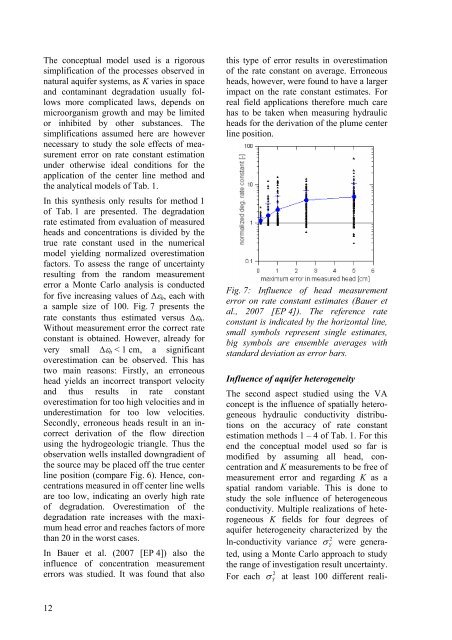Applied numerical modeling of saturated / unsaturated flow and ...
Applied numerical modeling of saturated / unsaturated flow and ...
Applied numerical modeling of saturated / unsaturated flow and ...
You also want an ePaper? Increase the reach of your titles
YUMPU automatically turns print PDFs into web optimized ePapers that Google loves.
The conceptual model used is a rigorous<br />
simplification <strong>of</strong> the processes observed in<br />
natural aquifer systems, as K varies in space<br />
<strong>and</strong> contaminant degradation usually follows<br />
more complicated laws, depends on<br />
microorganism growth <strong>and</strong> may be limited<br />
or inhibited by other substances. The<br />
simplifications assumed here are however<br />
necessary to study the sole effects <strong>of</strong> measurement<br />
error on rate constant estimation<br />
under otherwise ideal conditions for the<br />
application <strong>of</strong> the center line method <strong>and</strong><br />
the analytical models <strong>of</strong> Tab. 1.<br />
In this synthesis only results for method 1<br />
<strong>of</strong> Tab. 1 are presented. The degradation<br />
rate estimated from evaluation <strong>of</strong> measured<br />
heads <strong>and</strong> concentrations is divided by the<br />
true rate constant used in the <strong>numerical</strong><br />
model yielding normalized overestimation<br />
factors. To assess the range <strong>of</strong> uncertainty<br />
resulting from the r<strong>and</strong>om measurement<br />
error a Monte Carlo analysis is conducted<br />
for five increasing values <strong>of</strong> ��h, each with<br />
a sample size <strong>of</strong> 100. Fig. 7 presents the<br />
rate constants thus estimated versus ��h.<br />
Without measurement error the correct rate<br />
constant is obtained. However, already for<br />
very small ��h < 1 cm, a significant<br />
overestimation can be observed. This has<br />
two main reasons: Firstly, an erroneous<br />
head yields an incorrect transport velocity<br />
<strong>and</strong> thus results in rate constant<br />
overestimation for too high velocities <strong>and</strong> in<br />
underestimation for too low velocities.<br />
Secondly, erroneous heads result in an incorrect<br />
derivation <strong>of</strong> the <strong>flow</strong> direction<br />
using the hydrogeologic triangle. Thus the<br />
observation wells installed downgradient <strong>of</strong><br />
the source may be placed <strong>of</strong>f the true center<br />
line position (compare Fig. 6). Hence, concentrations<br />
measured in <strong>of</strong>f center line wells<br />
are too low, indicating an overly high rate<br />
<strong>of</strong> degradation. Overestimation <strong>of</strong> the<br />
degradation rate increases with the maximum<br />
head error <strong>and</strong> reaches factors <strong>of</strong> more<br />
than 20 in the worst cases.<br />
In Bauer et al. (2007 [EP 4]) also the<br />
influence <strong>of</strong> concentration measurement<br />
errors was studied. It was found that also<br />
12<br />
this type <strong>of</strong> error results in overestimation<br />
<strong>of</strong> the rate constant on average. Erroneous<br />
heads, however, were found to have a larger<br />
impact on the rate constant estimates. For<br />
real field applications therefore much care<br />
has to be taken when measuring hydraulic<br />
heads for the derivation <strong>of</strong> the plume center<br />
line position.<br />
Fig. 7: Influence <strong>of</strong> head measurement<br />
error on rate constant estimates (Bauer et<br />
al., 2007 [EP 4]). The reference rate<br />
constant is indicated by the horizontal line,<br />
small symbols represent single estimates,<br />
big symbols are ensemble averages with<br />
st<strong>and</strong>ard deviation as error bars.<br />
Influence <strong>of</strong> aquifer heterogeneity<br />
The second aspect studied using the VA<br />
concept is the influence <strong>of</strong> spatially heterogeneous<br />
hydraulic conductivity distributions<br />
on the accuracy <strong>of</strong> rate constant<br />
estimation methods 1 – 4 <strong>of</strong> Tab. 1. For this<br />
end the conceptual model used so far is<br />
modified by assuming all head, concentration<br />
<strong>and</strong> K measurements to be free <strong>of</strong><br />
measurement error <strong>and</strong> regarding K as a<br />
spatial r<strong>and</strong>om variable. This is done to<br />
study the sole influence <strong>of</strong> heterogeneous<br />
conductivity. Multiple realizations <strong>of</strong> heterogeneous<br />
K fields for four degrees <strong>of</strong><br />
aquifer heterogeneity characterized by the<br />
ln-conductivity variance 2<br />
� Y were generated,<br />
using a Monte Carlo approach to study<br />
the range <strong>of</strong> investigation result uncertainty.<br />
� at least 100 different reali-<br />
For each 2<br />
Y

















